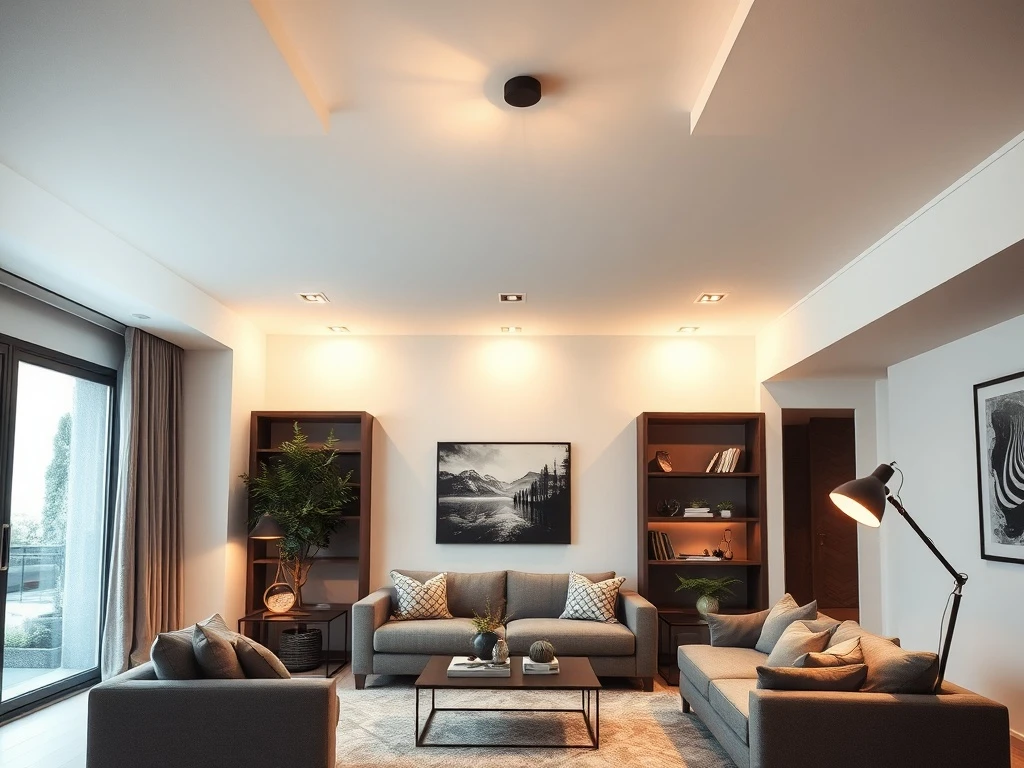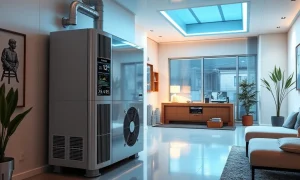Lighting does more than just help you see; it sets the mood and makes each part of your home feel alive. Indeed, whether you’re fixing up one area or rethinking your whole place, getting your efficient lighting right can truly make a significant difference. Different rooms call for different types of illumination, so it helps to plan with both style and function in mind. This article will teach you how to select the right efficient lighting for your home, ensuring both beauty and savings.
Understanding Room Function for Efficient Lighting
Before you start picking out bulbs or light fittings, you must think about how each room is used. Consequently, the purpose of a space directly influences its lighting needs. For instance, in spots like bathrooms or home offices, where good visibility matters, task lighting is essential. This focused illumination ensures you can perform detailed activities without strain. Conversely, for places like living rooms or bedrooms, ambient lighting helps set a relaxing mood. This general illumination creates a comfortable base layer.
Furthermore, when you match the efficient lighting to the room’s job, everything feels more natural and easier to use. Consider these key functions:
- Ambient Lighting: Provides overall illumination for a room.
- Task Lighting: Focuses light on specific areas for activities.
- Accent Lighting: Highlights architectural features or decor.
By defining the room’s primary use, you can make smarter decisions about your lighting design. This proactive approach saves time and money.
Layering Light for Optimal Ambiance and Efficiency
To achieve a balanced feel, use different layers of light. First, start with general lighting that covers the whole space. This includes ceiling lights or large LED panels. This foundational layer provides overall brightness. Next, follow that up with focused task lighting. Reading lamps, desk lights, or kitchen strip lights fall into this category. They provide concentrated light where needed.
Finally, accent lighting is for those small things you want to display. Think about lighting shelves or a large artistic corner. Putting all three layers together gives you versatile efficient lighting. This adaptable system can suit different moods or times of day. Moreover, layering allows you to adjust brightness and focus, optimizing energy use. You can dim ambient lights while keeping task lights bright, for example.
Selecting Fixtures that Complement Your Decor
Once you’ve handled the practical stuff, the type of fixture you choose profoundly changes the look of a room. In smaller spaces, it’s best to stick with flush or recessed lights. These fixtures do not take up much room, making the space feel larger. Keep in mind that bigger spaces or rooms with high ceilings are great for pendant lights or statement pieces like chandeliers. These can serve as focal points.
Additionally, consider the materials and finishes of your fixtures. Whether it’s timber, glass, or brushed metal, choose finishes that blend in well with your existing decor. A consistent aesthetic enhances the room’s overall appeal. The right fixture not only provides light but also acts as a decorative element, contributing to the overall design scheme. Thoughtful selection ensures your efficient lighting fixtures enhance both function and style.
Embracing Energy-Saving and Smart Lighting Solutions
Going for energy-saving lights isn’t just good for the planet; it’s good for your wallet, too. Today, efficient lighting primarily means LED bulbs. These are cost-effective and run for years without needing bulb changes. Their longevity significantly reduces maintenance efforts and costs. If the idea of smart tech appeals, there are bulbs you can control via your phone or with voice commands. These work well if you are on the road or just want to be in charge without having to move.
Smart lighting systems offer numerous benefits:
- Remote Control: Manage lights from anywhere.
- Scheduling: Automate on/off times for security and convenience.
- Dimming: Adjust brightness to save energy and set moods.
- Color Changing: Some smart bulbs offer a full spectrum of colors.
These advanced options make your home more comfortable and significantly reduce electricity consumption. Investing in smart, efficient lighting pays off in the long run through lower utility bills and increased convenience.
Maximizing Natural Light for Enhanced Efficiency
Keep in mind that rooms with big windows or skylights might not need much extra lighting during the day. You can use light curtains or blinds that cut down on glare but still let the sun shine through. This strategy brightens the room naturally. In darker areas, you can use mirrors or light-coloured walls to help reflect whatever natural light there is. This makes the space feel brighter and can lessen how often you need to switch on extra lamps.
Furthermore, positioning furniture strategically can also help. Avoid blocking windows with large pieces. Natural light not only saves energy but also positively impacts mood and well-being. Incorporating natural light effectively is a cornerstone of truly efficient lighting design. It reduces reliance on artificial sources, leading to lower energy consumption and a more pleasant living environment.
Choosing the Right Bulbs and Color Temperatures
Bulbs that give off a warm white glow are great for bedrooms and lounge areas. They feel cosy and promote relaxation. Conversely, cool white light works better in places like bathrooms and kitchens. In these areas, you need everything to look clear and vibrant. Look at how bright a bulb is, which is measured in lumens. The more lumens it has, the brighter it will be.
Color temperature is measured in Kelvin (K). Here’s a quick guide:
- Warm White (2700K-3000K): Ideal for living rooms, bedrooms, and dining areas. Creates a soft, inviting atmosphere.
- Cool White (3500K-4500K): Best for kitchens, bathrooms, and home offices. Provides a crisp, clear light for tasks.
- Daylight (5000K-6500K): Mimics natural daylight, suitable for workshops or areas requiring high concentration.
However, if you’re unsure, someone at the store can always help you figure it out. Selecting the correct color temperature is crucial for optimizing both the function and feel of your efficient lighting setup.
Tailoring Efficient Lighting for Specific Rooms
Applying the principles of efficient lighting to individual rooms ensures optimal functionality and ambiance. Each space has unique requirements.
Kitchen Lighting for Culinary Tasks
The kitchen demands highly functional lighting. Install bright task lighting directly over countertops and the stove. Under-cabinet strip lights are perfect for this. Overhead ambient lighting, like recessed lights or a large flush mount, provides general illumination. Consider dimmable options for evening entertaining. Accent lighting can highlight glass cabinets or a backsplash, adding a touch of elegance. This layered approach makes your kitchen both practical and inviting.
Bathroom Illumination for Clarity and Comfort
In bathrooms, clarity is key. Place task lighting around the mirror, ideally at eye level, to eliminate shadows for grooming. Vanity lights or sconces on either side of the mirror work well. Overhead ambient lights ensure overall brightness. Furthermore, consider a separate, softer light for relaxation, perhaps a dimmable recessed light over the tub. Moisture-rated fixtures are essential for safety and longevity in this environment. Therefore, choose fixtures designed for damp locations.
Bedroom Lighting for Rest and Relaxation
Bedrooms require warm, soothing light. Start with dimmable ambient lighting, such as a ceiling fixture or several recessed lights. Bedside lamps provide task lighting for reading. Consider wall-mounted sconces for a cleaner look. Accent lighting can highlight artwork or a feature wall. Dimmers are crucial here, allowing you to adjust the mood from bright for dressing to soft for winding down. The goal is to create a serene retreat with your efficient lighting.
Living Room Lighting for Versatility
Living rooms are multi-functional spaces, requiring flexible lighting. Use ambient lighting from ceiling fixtures or track lights. Add task lighting with floor lamps or table lamps for reading nooks. Accent lighting can highlight architectural details or art. A combination of these layers, all on separate switches or dimmers, allows you to adapt the lighting for various activities, from movie nights to social gatherings. This versatility is a hallmark of good efficient lighting design.
Home Office Lighting for Productivity
A home office needs focused, glare-free illumination. A good desk lamp provides essential task lighting for computer work and reading. Overhead ambient lighting should be even and bright, avoiding harsh shadows. Consider placing lights to minimize screen glare. Natural light is highly beneficial; position your desk to take advantage of windows. Proper efficient lighting in a home office can significantly boost productivity and reduce eye strain.
Advanced Lighting Controls for Ultimate Efficiency
Beyond the bulbs and fixtures, advanced controls further enhance your efficient lighting system. Dimmers are perhaps the most common and effective tool. They allow you to adjust the brightness, saving energy and setting the perfect mood. Installing dimmers on all ambient and many task lights is a wise investment. Moreover, motion sensors are excellent for utility rooms, hallways, or outdoor areas. They ensure lights are only on when someone is present, preventing wasted energy.
Timers offer another layer of convenience and security. You can program lights to turn on and off at specific times, even when you’re away. This creates an occupied look, deterring potential intruders. Integrating your efficient lighting with a smart home system provides centralized control. You can manage all your lights from a single app, create custom scenes, and even link them with other smart devices. These controls transform your lighting from simple illumination to an intelligent, energy-saving system.
Good lighting isn’t just about seeing; it’s about feeling good in your home. The right light can help you focus during the day, relax in the evening, and enjoy your space more overall. When you plan around how each room is used and mix in smart choices with your style, your home ends up working better. A bit of planning now means less hassle later and lights that bring warmth and clarity to everyday life. Ultimately, investing in thoughtful and efficient lighting solutions truly elevates your living experience.
Frequently Asked Questions (FAQs) About Efficient Lighting
What are the three main layers of efficient lighting?
The three main layers are ambient (general), task (focused), and accent (decorative) lighting. Combining these layers creates a versatile and functional lighting scheme for any room.
Why should I choose LED bulbs for my home?
LED bulbs are highly recommended for their energy efficiency, long lifespan, and durability. They consume significantly less electricity than traditional bulbs, leading to substantial savings on utility bills and reducing the frequency of bulb replacements.
How can natural light improve a room’s efficiency?
Maximizing natural light reduces the need for artificial lighting during the day, saving energy. It also creates a brighter, more open feel and can positively impact mood and productivity. Strategies include using sheer curtains, reflective surfaces, and strategic furniture placement.
What color temperature is best for a bedroom?
For bedrooms, a warm white color temperature (around 2700K-3000K) is generally best. This range creates a cozy, relaxing atmosphere conducive to rest and sleep.
Are smart lighting systems truly energy efficient?
Yes, smart lighting systems can significantly enhance energy efficiency. They allow for precise control, including dimming, scheduling, and remote access, which helps ensure lights are only on when and where needed, minimizing wasted energy.
How often should I clean my light fixtures?
Regular cleaning of light fixtures, typically every few months, helps maintain their efficiency and brightness. Dust and dirt can accumulate on bulbs and shades, reducing light output and potentially increasing energy consumption as the fixture works harder to produce light.






















